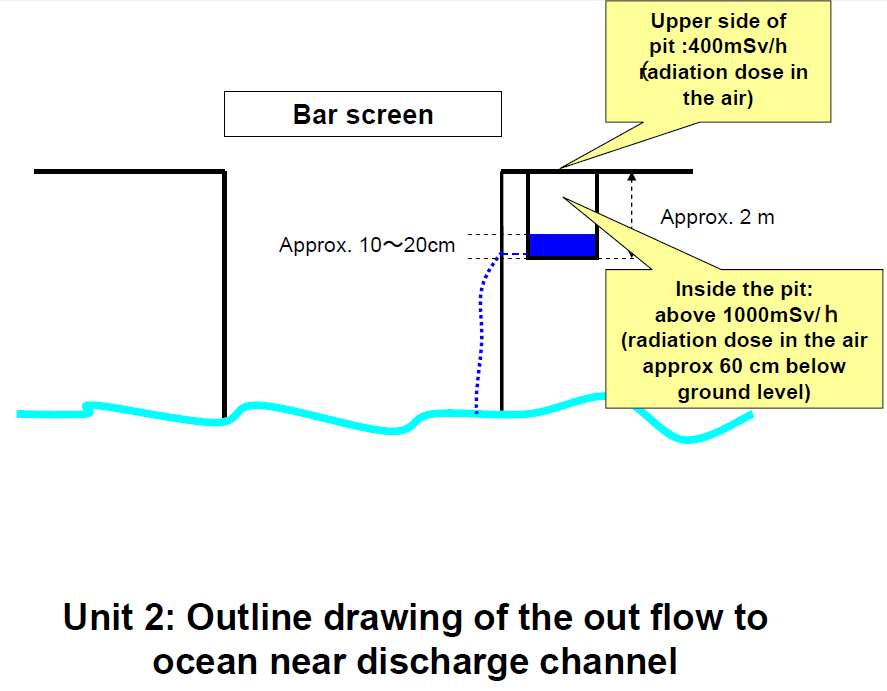Extremely radioactive water, measured at (edit at 9pm in bold) over 1000 millisieverts per hour in air above the water, is flowing from a damaged pit, servicing the number 2 reactor at Fukushima, through an 8 inch crack, directly into the ocean according to the deputy director of Japan's nuclear safety agency. Technicians are attempting to seal the crack with concrete. (Apparently TEPCO's instruments peg out at 1 Sievert per hour, so 1000 millisieverts per hour is a lower bound, 9pm update.)
The operator of the plant said that air directly above the water leaking into the sea had a radiation reading of more than 1,000 millisieverts an hour, said Hidehiko Nishiyama, deputy director-general of the Nuclear and Industrial Safety Agency. Although higher levels of radiation have been detected in the ocean waters near the plant, the leak discovered Saturday is the first identified direct leak of such high levels of radiation into the sea. Earlier Saturday, Mr. Nishiyama had said that above-normal levels of radioactive materials were detected about 25 miles south of the Fukushima plant, much further than had previously been reported.
Because one third of the reactor core of unit 2 has apparently melted down, according to estimates by experts, a large inventory of cesium 137 and strontium 90 may have entered the ocean. These isotopes have half lives of about 30 years. Cesium 137 tends to adsorb onto clay minerals and organic matter. Cesium is taken up by the tissues of plants, where it acts like potassium. Strontium 90 tends to be taken up into the shells and bones of marine organisms, where it acts like calcium. Cs-137 and Sr-90 are present in minute amounts. They become radiologically toxic at extremely low concentrations, before they have any other toxic effects on cells.
TEPCO and Japan's nuclear safety agency have not released measurements of radionuclides in water. This is a preliminary report.
“With radiation levels rising in the seawater near the plant, we have been trying to confirm the reason why, and in that context, this could be one source. We’re testing samples of water from the pit and from the sea near the plant, and we can’t really say for certain until we’ve studied the results,” he said.
Radioactive iodine has been previously measured at high levels in sea water near the devastated Fukushima reactors, but most of the iodine inventory is in short lived isotopes. The longer lived isotopes will quickly disperse through the ocean because iodine is highly soluble and mobile. Over a period of years the cesium 137 and strontium 90 are likely to have the greatest effect on the marine food chain, in my opinion.
FYI, I have had experience managing research projects on the migration of nuclear waste leachates in the environment from low level waste sites, uranium mill tailings piles and the Hanford N reactor. Strontium 90 was the limiting isotope contaminating the Columbia river that caused the slit trenches at the N reactor to be shut down. I would expect strontium 90 to be a major concern if partially melted down fuel has been partially dissolved by application of sea water to the crippled reactor. Cesium 137, which is more volatile than strontium, and is also very soluble, is definitely a concern.
Levels of radioactive materials have been skyrocketing in the sea near the nuclear power plant hit by the March 11 earthquake and tsunami, fanning concerns about the expansion of sea contamination and the impact on fishery products.
Long shore currents in this region of Japan have been reported to flow towards the south. Generally, in humid areas like Japan and the east coast of the U.S., low salinity water, that originated partially in rivers, flows along the coastline, slowly mixing with open ocean water. This zone of relatively fresh water could transport radionuclides miles to the south along the shore.
 TEPCO drawing
TEPCO drawing